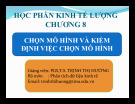Advanced Econometrics - Part II
Chapter 2: Hypothesis Testing
Chapter 2
HYPOTHESIS TESTING
n
f Z (
θ , )
→
=
θ arg max ( )
i
ˆ θ MLE
= ∏ θ ( )
θ
= 1
i
n
=
L
θ ( )
ln (
f Z
θ , )
θ ln ( )
i
= ∑
= i 1
I. MAXIMUM LIKELIHOOD ESTIMATORS:
=
0
• Asymptotic normality:
∂ L ∂ θ
− 1
2
ˆ θ MLE
∂ L ∂ ∂ θ θ '
θ ~ N , -E
2
I
= Eθ ( )
for Solve: MLEθˆ
( ×k
)1
∂ L θ θ ∂ ∂ '
∂ ∂ L L θ θ ∂ ∂
′
= − E
θ
=
∂ L ∂ θ
θ 1 θ 2 kθ
∂ L ∂ θ 1 ∂ L θ ∂= 2 ∂ L ∂ θ k
2
2
2
2
2
2
2
∂ L θ θ ∂ ∂ 1 2 ∂ L 2 θ ∂ 2
∂ L ′ θ θ ∂ ∂
2
∂ L θ θ ∂ ∂ 1 k ∂ L θ θ ∂ ∂ 2 k 2
1
∂ ∂ L L θ θ θ θ ∂ ∂ ∂ ∂ k k 2
∂ L 2 θ ∂ k
∂ L 2 θ ∂ 1 ∂ L = ∂ ∂ θ θ 2 1 2
θ vector
=
(
Y × )1 n
(
(
+ εβ X × )1 n × × )1 )( kkn
University of New England
Nam T. Hoang UNE Business School
1
• For the linear model:
Advanced Econometrics - Part II
Chapter 2: Hypothesis Testing
=→
XY
e
ε
σ
N ,0(~
ˆ β+ 2I
)
−=
π
−
2 σ
−
β
L
− XY (
′ ()
− XY
β )
2 σβ ( ,
)
2ln
ln
n 2
n 2
1 2 σ 2
= )0(
′
−
′ + X Y X X
(
β )
L 1 = − 2 β σ
= −
β
− Y X (
′ ) (
− Y X
β )
2
= )0(
∂ ∂ ∂ L ∂ 2 σ
n 1 + 2 σ σ 2
2
− 1
e 1 e
=
e
2 ne
− 1
− 1
(
X X '
)
0
2
−
=
E
4 σ 2
∂ L ′ ∂ ∂ θ θ
0
2 σ
n
c
q
=)(θ
= ( ) ' YX → = = ()ˆ ′ β )ˆ β − ( XY − XY ˆ β 2 σ ˆ ' XX 1 n ' ee n
• We consider maximum likelihood estimator θ & the hypothesis:
II. WALD TEST
• Let θˆ be the vector of parameter estimator obtained without restrictions.
θˆ is restriction MLE of θ cH q • We test the hypothesis: =)(:0 θ
−)ˆ(θ
c
q
If the restriction is valid, then should be close to zero. We reject the •
hypothesis of this value significantly different from zero.
− 1
−
−
)ˆ([ θ
]
= cW
)ˆ([ θ c
q
)ˆ([ θ c
q
( ′− ] q Var
) ]
• The Wald statistic is:
cH q =)(:0 θ Under:
• W has chi-squared distribution with degree of freedom equal to the number of
)ˆ( c θ
=− q
0
2 JX~W [ ]
University of New England
Nam T. Hoang UNE Business School
2
restrictions (i.e number of equations in )
Advanced Econometrics - Part II
Chapter 2: Hypothesis Testing
III. LIKELIHOOD RATIO TEST:
cH q =)(:0 θ •
Uθˆ be the maximum likelihood estimator of θ obtained without
Let
restriction.
Let Rθˆ be the MLE of θ with restrictions.
ˆ&ˆ L L U
R
If are the likelihood functions evaluated at these two estimate.
R
=λ
ˆ L ˆ L U
The likelihood ratio:
)1 ≤≤ λ
( 0
c
=)(θ
q
RLˆ should be close to ULˆ .
λ
ln2
X~
θ )(:
−→= q
If the restriction is valid then
cH 0
2 [ ] J
is chi-squared, with degree of freedom equal to the • Under
ln2 λ−=LR
2 JX~ [ ]
number of restrictions imposed.
IV. LAGRANGE MULTIPLIER TEST (OR SCORE TEST):
cH q =)(:0 θ
Let λ be a vector of Lagrange Multipliers, define the Lagrange function:
( ) θ
* L
[ ( ) ′+ θλθ )( c
]q
= − L
′
=
+
λ
=
0
( ) ∂ θ L ∂ θ
( ) ∂ θ c ′ ∂ θ
=
c
− = q
0
( ) θ
( ) * ∂ θ L ∂ θ ( ) θ λ
∂ * L ∂
University of New England
Nam T. Hoang UNE Business School
3
The FOC is:
Advanced Econometrics - Part II
Chapter 2: Hypothesis Testing
)
If the restrictions are valid, then imposing them will not lead to a significant difference
ˆ( ∂ L θ R ˆ ∂ θ R
in the maximized value of the likelihood function. This means is close to 0 or λ
is close to 0. We can test this hypothesis:
− 1
2
∂
)
)
=
LM
E
ˆ ∂ θ L ( R ˆ ∂ θ R
ˆ θ L ( ) R ˆ ˆ ′ ∂ ∂ θ θ R R
ˆ ∂ θ L ( R ˆ ∂ θ R
′
−
leads to LM test. cH →= q )(:0 θ
Under the null hypothesis LM has a limiting chi-squared distribution with 0 =λH :0
degrees of freedom equal to the number of restrictions.
Graph
V. APPLICATION OF TESTS PROCEDURES TO LINEAR MODELS
(
(
(
(
=
(
R )kj ×
RH β 0 : ) ( × kj
qq ( )1 × j
= = ˆ β + Model: X Y × )1 n e )1 × n εβ + X × )1 n × × )1 )( kkn
βˆ is an MEE of β (unrestriction)
− 1
′
′
ˆ β
−
ˆ β
−
2 σ ˆ
(
) − 1 RXX
q
X~
( = RW
)
′ [ ) Rq
1. Wald test:
] ( R
2 [ ] J
=2ˆσ
βˆ is an unrestriction estimator of β:
ee′ n
′− ee
)
=
W
2 JX~ [ ]
′ een ( RR ′ ee
It can be shown that:
−=
βˆ
(1)
e
XY
R
R
Rβˆ is an estimator subject to the restriction βR .
University of New England
Nam T. Hoang UNE Business School
4
With
Advanced Econometrics - Part II
Chapter 2: Hypothesis Testing
2. LR test:
)
X
λ=
,ˆ( β L R ,ˆ( β L X
)
RH q =β:0
−= = − λ LR L ln2 )ˆ( β ln
[ ln2
] JX~)ˆ( 2 β RL [ ]
=
−
LR
n
(ln
ln
′ ee
)
′ ee RR
βˆ
−=
e
XY
R
R
It can be shown:
3. LM test:
0 :H R
qβ =
− 1
− 1
It can be shown:
R
R
R
) ′ eX ) ′ eX ) ′ R = = = (3) LM ′ XXXne ( 2 σ ˆ ′ ( XXXen ′ ee RR ′ ′− ( een ee RR ′ ′ ee RR
2
)
)
′− ee
′− ee
′− ee
+
−
=
It can be shown:
LR
′ ( een RR ′ ee
′− ee ′ ee
2 =
′ een RR 2
′ ( een RR ′ ee RR
′ een RR ′ 2 ee RR
(2)
From (1), (2), (3) we have:
≥
≥
W
LR
LM
For the linear models:
The tests are asymptotically equivalent but in general will give different numerical
results in finite samples.
Which test should be used?
The choice among would, LR & LM is typically made on the Basic of ease of
computation. LR require both restrict & unrestrict. Wald require only unrestrict & LM
University of New England
Nam T. Hoang UNE Business School
5
requires only restrict estimators.
Advanced Econometrics - Part II
Chapter 2: Hypothesis Testing
VI. HAUSMAN SPECIFICATION TEST:
- Consider a test for endogeneity of a regressor in linear model.
ˆβ estimators. Where
ˆβ uses
- Test based on comparisons between two different estimators are called Hausman Test.
OLSβˆ & SLS
2
2
SLS
- Two alternative estimators are:
H
SLS
ˆ: β ≈ OLS
ˆ β 2
0
instruments to control for possible endogeneity of the regressor:
− 1
Hausman’s statistic:
− ˆ β − ˆ β − ˆ β ) ) ~)
[ ′ VarCov
]
2 χ [ ] r
SLS
OLS
OLS
SLS
SLS
OLS
ˆ( β 2 ˆ( β 2 ˆ( β 2
r: the number of endogenous regressors.
~ consider two estimators θˆ and θ
Model general:
plim(
ˆ = θ θ− )
0
We consider the test situation where:
plim(
ˆ ≠ θ θ− )
0
H0 :
~ˆ( →− θθ )
n
N
,0(
Var
~ˆ( − θθ
))
HA :
Assume under H0 :
− 1
=
~ˆ( − θθ )
~)
H
Var
~ˆ( 2 − χθθ [ ] q
1 n
~ˆ( − θθ )
The Hausman test statistic:
~ -ˆ( θθVar )
q is rank of
−
ˆ β
=
−
VarCov
VarCov
VarCov
)
)
ˆ( β
)
ˆ( β 2
SLS
OLS
ˆ( β 2
SLS
OLS
University of New England
Nam T. Hoang UNE Business School
6
For the linear model:
Advanced Econometrics - Part II
Chapter 2: Hypothesis Testing
VII. POWER AND SIZE OF TESTS:
Size of a test:
Size = Pr[type I error]
= Pr[reject H0 | H0 true]
05.0=α
Common choices: 0.01, 0.05 or 0.1,
Monte-Carlo: set H0 true, → see the probability of reject H0 → size
Power of a test:
Power = Pr [reject H0/H0 wrong]
= 1 - Pr[accept H0/H0 wrong]
= 1 - Pr[Type II error]
University of New England
Nam T. Hoang UNE Business School
7
Monte-Carlo: set H0 wrong, → see the probability of reject H0 → power size.

![Bài giảng Kinh tế lượng [mới nhất]](https://cdn.tailieu.vn/images/document/thumbnail/2025/20250805/vijiraiya/135x160/303_bai-giang-kinh-te-luong.jpg)


![Bài giảng Kinh tế lượng Trường Đại học Điện lực [Mới nhất]](https://cdn.tailieu.vn/images/document/thumbnail/2025/20250718/vijiraiya/135x160/362_bai-giang-kinh-te-luong-truong-dai-hoc-dien-luc.jpg)
![Bài giảng Kinh tế lượng môn học: Tổng hợp kiến thức [chuẩn nhất]](https://cdn.tailieu.vn/images/document/thumbnail/2025/20250718/vijiraiya/135x160/159_bai-giang-mon-hoc-kinh-te-luong.jpg)




















